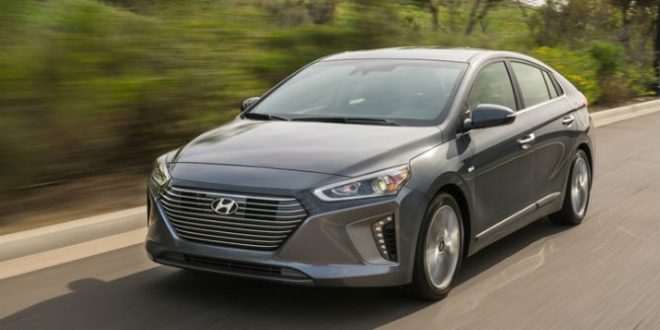The 2017 Hyundai Ioniq is a small hatchback that comes as a hybrid, a plug-in hybrid, or an all-electric model; it’s an important new player in the world of high-efficiency cars.
2017 Hyundai Ioniq Hybrid – All 2017 Hyundai Ioniq hybrids are powered by a 1.6L GDI Atkinson Cycle 4-cylinder engine. It makes 104 horsepower and 109 lb-ft of torque. There is a 240 V Lithium-ion Polymer battery pack with a capacity of 1.56 kWh. A 32 kW Electric Motor makes 43 horsepower and 124 lb-feet of torque. After some power reduction, the hybrid’s pull comes to a decent 139 hp combined.
Contrary to Toyota’s (and many other automaker’s) CVT philosophy, the 2017 Hyundai Ioniq comes with a six-speed dual-clutch transmission. The 2017 Hyundai Ioniq hybrid “Blue” is EPA-rated at 57 mpg city and 59 mpg highway. The 2017 Hyundai Ioniq Hybrid “SEL” and “Limited” are rated at 55 mpg city and 54 mpg highway.
Its base price of $22,200 is significantly less than the base Toyota Prius ($24,685).
Driving – Hyundai added a multilink, independent rear suspension to the 2017 Hyundai Ioniq hybrid – and it was the right call; the ride and handling are superb for this class. Aside from being piloted through rain-soaked roads, the route Hyundai chose for journalists included potholes, broken pavement and uneven surfaces.
The regenerative braking system is one of the most “regular-feel/car-like” that I have tested. That’s a good thing.
The front seats were plush and comfortable. Hyundai used fibrous components of sugarcane and bits of volcanic rock along with lots of recycled plastics in the making of the interior. It feels like a more premium interior than the price would suggest.
The transmission was smooth and downshifts were lightning fast. It made the 2017 Hyundai Ioniq feel a lot more like a conventional car. There was a tad bit of noise coming from the purpose-built Michelin Primacy MXM4 225/45R17 (the other Ioniq vehicles come with Michelin Energy Saver A/S 205/55R16 tires – which feel and sound about the same), but the comfort and grip on all three Ioniq(s) was impressive. It performed well in rain too.
My only performance gripe was the super light steering (on all three vehicles). It’s a motor-driven power steering (MDPS) column mounted, rack-and-pinion, power assisted system. While some commuters will appreciate the low effort steering, I like more heft and (at least) a simulated steering feel. The Prius and Prius Prime have a better steering feel.
2017 Hyundai Ioniq Plug-in Hybrid – The plug-in hybrid has many of the same components as the regular hybrid, like the same 1.6L GDI Atkinson Cycle 4-cylinder gas engine. The big difference comes from its beefier 44.5 kW Electric Motor that’s powered by a 360 V Lithium-ion Polymer battery pack with 8.9 kWh battery capacity.
Driving – Charge it up with a Level 2 – 220/240V charger (it takes about 2 1/2 hours if you’re totally empty) and you’ll get “Greater than 27 miles” of all electric range, according to Hyundai. Its overall range is over 600 miles on a tank of gas (11.9 gallons for the hybrid and 11.4 gallons for the plug-in).
While the 2017 Hyundai Ioniq Plug-in Hybrid I drove was still a prototype, it felt exactly the same as the regular hybrid. I never felt the change from electric to gas power, it was almost seamless. While the plug-in is a heavier car, it still has the terrific independant rear suspension and top-notch road manners.
Numbers like EPA mpg numbers and price were unavailable during the press event.
If Hyundai can undercut the Toyota Prius Prime the same way they usurped the regular Prius, the Ioniq Plug-in could be a hell of a bargain. The 2017 Hyundai Ioniq Hybrid and Electric are already hitting a few dealerships (the Ioniq Electric is coastal for now), but the Ioniq Plug-in Hybrid waits until the summer of 2017.
2017 Hyundai Ioniq Electric – The 2017 Hyundai Ioniq Electric is has an 88-kW electric motor that makes 118 hp and 215 lb-ft of torque. A 28 kWh lithium-ion polymer battery pack provides an estimated 124 miles of range. A single-speed reduction gear transmission is unique to the Ioniq Electric. It also differentiates the interior as its a nice-looking push-button setup where the gear selector normally resides.
It’s rated at 136 MPGe.
Agencies/Canadajournal

 Canada Journal – News of the World Articles and videos to bring you the biggest Canadian news stories from across the country every day
Canada Journal – News of the World Articles and videos to bring you the biggest Canadian news stories from across the country every day

